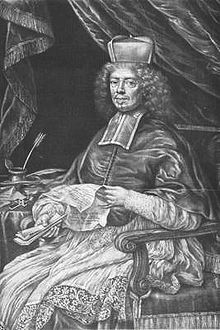Leopold Karl von Kollonitsch
Leopold Karl von Kollonitsch | |
|---|---|
| Cardinal,Archbishop of Esztergom Primate of Hungary | |
 Kollonitsch,mezzotintbyChristoph Weigel | |
| Installed | 14 July 1695 |
| Term ended | 20 January 1707 |
| Predecessor | György Széchényi |
| Successor | Christian August of Saxe-Zeitz |
| Orders | |
| Ordination | 25 February 1668 |
| Created cardinal | 1686 |
| Personal details | |
| Born | 26 October 1631 |
| Died | 20 January 1707(aged 75) Vienna,Habsburg monarchy |
| Buried | Pressburg |
| Nationality | Hungarian |
| Denomination | Roman Catholic |
| Parents | Count Ernst von Kollonitsch Anne Elizabeth von Kueffstein |
| Signature |  |
| Coat of arms |  |
Leopold Karl von Kollonitsch(also speltCollonicz,Colonitz,Kollonitz,KolonitsandKolonić;26 October 1631 – 20 January 1707) orLipót Kollonichwas acardinalof theHoly Roman Church,Archbishop of Kalocsaand later ofEsztergom,and Primate of Hungary. Also acountof theHoly Roman Empire,he was a leading figure of the HungarianCounter-Reformation.
As an imperial minister, Kollonitsch was responsible for reorganizing the new Hungarian territorieswonfrom theOttoman Empireand later ceded at theTreaty of Karlowitz.He was said to have gained over one hundred thousand converts to Rome fromOrthodox Christianity.
Early life and military career
[edit]
Born at theHungariancastle ofKomárom (now Komárno),Leopold Karl von Kollonitsch was the son of Count Ernst von Kollonitsch, Governor of the castle, by his marriage to Anne Elizabeth von Kueffstein. He became a candidate officer of theSovereign Military Order of Malta,first seeing action in theCretan War,when the Knights of Malta supportedVeniceagainst the Turks.[1]
In 1650 he wasknightedat Vienna. In 1654 he took part in thedefence of Crete,and in 1655 he fought at theBattle of the Dardanelles,a victory for Venice. He became aKnight Hospitallerin 1658 and was next appointed as Prior and Castellan of the Order of Mailberg, based atSchloss Mailberg.Soon he was also in command ofEgerinBohemia.[1][2]
Churchman
[edit]
In 1659, theEmperor Leopold Iappointed Kollonitsch as his Lord Chamberlain and also named him asBishop of Nitra.Kollonitsch then began some studies intheology,but he was not ordained apriestuntil 1668.[1]In 1669, he was enthroned as bishop of Nitra. In 1670, he was translated to becomeBishop of Wiener Neustadt,the "new city" ofVienna,succeeding Laurenz Aidinger.[3]From 1672 to 1681, he was president of the Hungarian Court Chamber.[1]
In 1673–74, Kollonitsch was responsible, with ArchbishopGyörgy Szelepcsényi,for a Special Court inPressburgwhich tried some 278 Protestants, resulting in their condemnation and expulsion.[1]
In 1683, at the time of the secondSiege of Viennaby the Turks, Kollonitsch went to the city, taking money to pay troops and also establishing emergency hospitals in monasteries there. After theBattle of Kahlenbergon 11 and 12 September 1683 which lifted the siege, he organized the care of some five hundred orphans atSchloss Mailberg,children whose parents had been killed in the conflict. In the years which followed, he founded the first military hospitals, as a result of which he enjoyed great popularity in Vienna.[1]
In 1685, Kollonitsch was appointedBishop of Győr,in Hungary, and gave up his diocese in Austria, where he was succeeded byCristoval Royas de Spinola.In 1686 he was named a cardinal, with the title of Cardinal-Priest ofSaint Jerome of the Croats,and in 1688 he was promotedArchbishop of Kalocsa.[3]In 1692 theEmperor Charles VImade him Minister of State, and in that capacity Kollonitsch was responsible for reorganizing the new Hungarian territories conquered from theOttoman Empire.In 1695, he was finally promoted to becomeArchbishop of Esztergom (or Gran)and Primate of Hungary, and was able to gain over 100,000 Orthodox Christians for Rome.[1]At the time Kollonitsch was the only Hungarian member of the Emperor's inner circle, and he was quoted as saying that he would "first render Hungary obedient, then destitute, and finally Catholic".[4]The Emperor never acted on the Cardinal archbishop's appeal for measures to bring about a massive conversion to Rome, but a document he issued in 1691 known as theExplanatio Leopoldinasuggested that religious freedom in the conquered lands was to be only temporary.[4]
Kollonitsch took part in thePapal conclavesof1689and1691,but was unable to attendthat of 1700.[3]He died at Vienna in 1707.[1]His body was laid to rest in theJesuits'Annakirche,then taken to Pressburg (nowBratislava) for burial.[2]
Memorials
[edit]In front of theRathausat Vienna stands a statue of Kollonitsch byVincenz Pilz.In 1862 a street in the city'sLandstraßedistrict was named after himKolonitzgasse,and in 1873 this was joined by theKolonitzplatz.[1]
Under Kollonitsch the settlement of the Capuchins inBratislavawas begun, and in 1708 the cornerstone of a Capuchin monastery was laid.[1]
Further reading
[edit]- Joseph Maurer,Cardinal Leopold Graf Kollonitsch, Primas von Ungarn: Sein Leben und sein Wirken(Innsbruck: Rauch, 1887)[1]
- Ernst Tomek, 'Kollonitsch, Leopold Karl' inLexikon für Theologie und Kirche,vol. 6 (Freiburg im Breisgau: Herder, 1934)
Notes
[edit]- ^abcdefghijFranz Krones, 'Kollonitsch, Leopold', inAllgemeine Deutsche Biographievol. 16 (Leipzig: Duncker & Humblot, 1882), pp. 481–484.
- ^abFranz Wißgrill, Karl von Odelga,Schauplatz des landsässigen Niederösterr. Adels,vol. 5 (1804),p. 196
- ^abcLeopold Karl Cardinal von Kollonitsch Lipót,catholic-hierarchy.org. Accessed 26 May 2013.
- ^abCharles Ingrao,The Habsburg Monarchy 1618–1815(Cambridge University Press, 2003;ISBN978-0-521-78505-1), p. 87.
- 1631 births
- 1707 deaths
- 17th-century Roman Catholic archbishops in Hungary
- 17th-century Hungarian cardinals
- 18th-century Hungarian cardinals
- Archbishops of Esztergom
- Archbishops of Kalocsa
- Bishops of Győr
- Knights of Malta
- Chief justices of Hungary
- Counts of Croatia
- Counts of Hungary
- Counts of the Holy Roman Empire
- Hungarian nobility
- Croatian nobility
- Hungarian people of Croatian descent
- People from Komárno
- Hungarian Roman Catholic archbishops
- Bishops of Nitra
